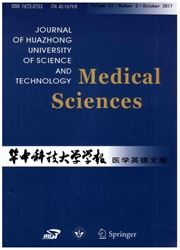

 中文摘要:
中文摘要:
In order to investigate the role of Toll-like receptor 4(TLR4) in cerebrocardiac syndrome(CCS), the partial cerebral ischemia/reperfusion(I/R) models in mice with different TLR4 genotypes were established in the present study. TLR4 wild-type(C3H/HeN) and mutant(C3H/HeJ) mice of 6–8 weeks of age were divided into 4 groups at random: C3H/HeN sham group(n=10), C3H/HeJ sham group(n=10), C3H/HeN model group(n=10) and C3H/HeJ model group(n=10). Partial cerebral I/R was caused by the middle cerebral artery occlusion(MCAO) to duplicate CCS models in mice. After the operation, the electrocardiogram(ECG), the level of tumor necrosis factor-alpha(TNF-α) in myocardial tissue and the cardiac pathological changes were observed in each group. It was shown that the brain infarct volume in C3H/HeN model group was larger than that in C3H/HeJ model group(P<0.01). The ST segment change and T wave inversion occurred frequently in model groups. Moreover, the TNF-α level in C3H/HeN model group was higher than that in C3H/HeJ model group(P<0.01). The myocardial injury was aggravated in C3H/HeN group as compared with C3H/HeJ group. It was concluded that TLR4 was implicated in the development of CCS.
 英文摘要:
英文摘要:
In order to investigate the role of Toll-like receptor 4 (TLR4) in cerebrocardiac syndrome (CCS), the partial cerebral ischemia/reperfusion (I/R) models in mice with different TLR4 genotypes were established in the present study. TLR4 wild-type (C3H/HeN) and mutant (C3H/HeJ) mice of 6-8 weeks of age were divided into 4 groups at random: C3H/HeN sham group (n=10), C3H/HeJ sham group (n=10), C3H/HeN model group (n=10) and C3H/HeJ model group (n=10). Partial cerebral I/R was caused by the middle cerebral artery occlusion (MCAO) to duplicate CCS models in mice. After the operation, the electrocardiogram (ECG), the level of tumor necrosis factor-alpha (TNF-c0 in myocardial tissue and the cardiac pathological changes were observed in each group. It was shown that the brain infarct volume in C3H/HeN model group was larger than that in C3H/HeJ model group (P〈0.01). The ST segment change and T wave inversion occurred frequently in model groups. Moreover, the TNF-ct level in C3H/HeN model group was higher than that in C3H/HeJ model group (P〈0.01). The myocar- dial injury was aggravated in C3H/HeN group as compared with C3H/HeJ group. It was concluded that TLR4 was implicated in the development of CCS.
 同期刊论文项目
同期刊论文项目
 同项目期刊论文
同项目期刊论文
 Improved Survival and Neurological Outcomes after Cardiopulmonary Resuscitation in Toll-like Recepto
Improved Survival and Neurological Outcomes after Cardiopulmonary Resuscitation in Toll-like Recepto 期刊信息
期刊信息
